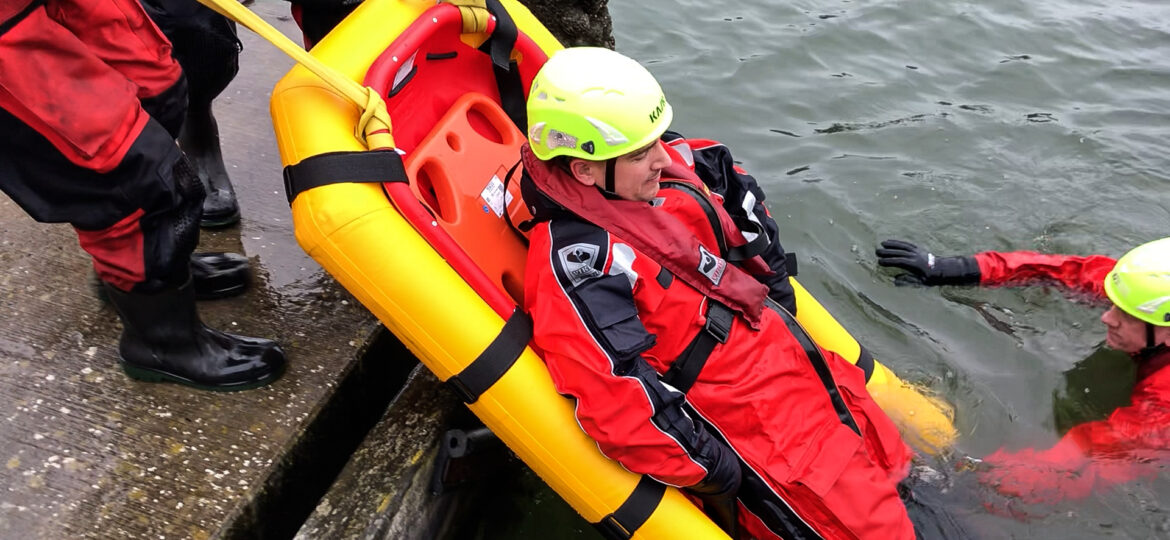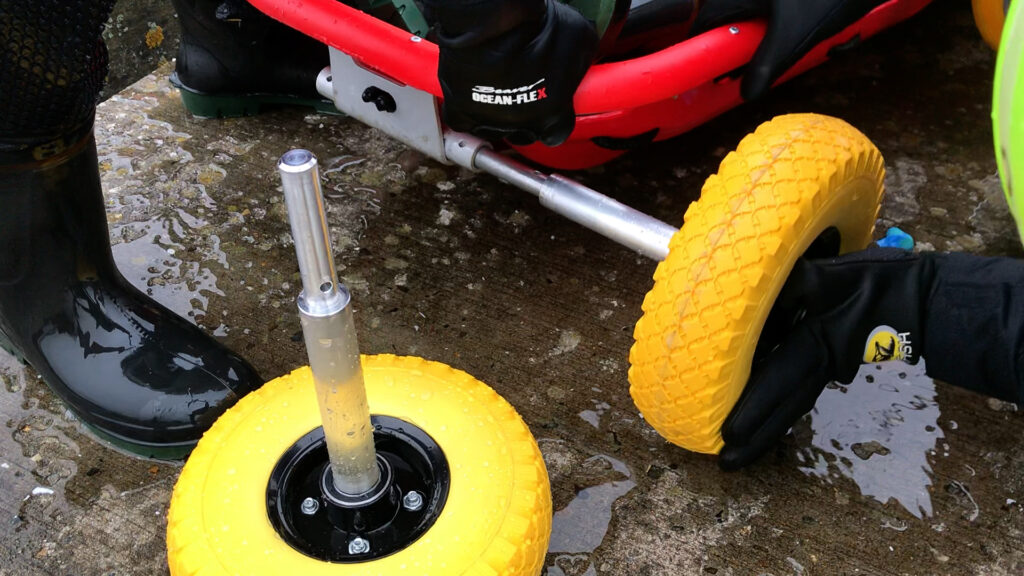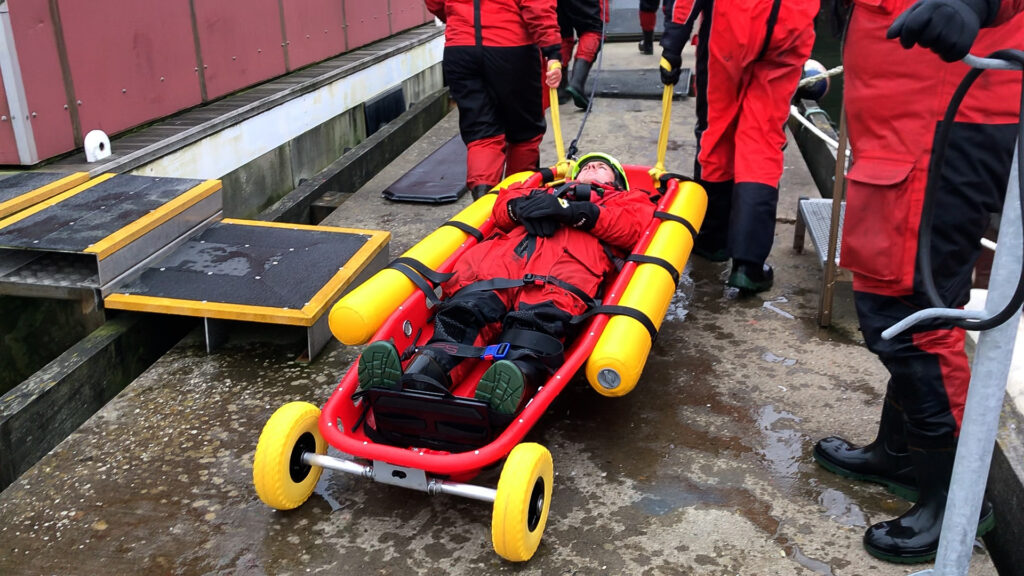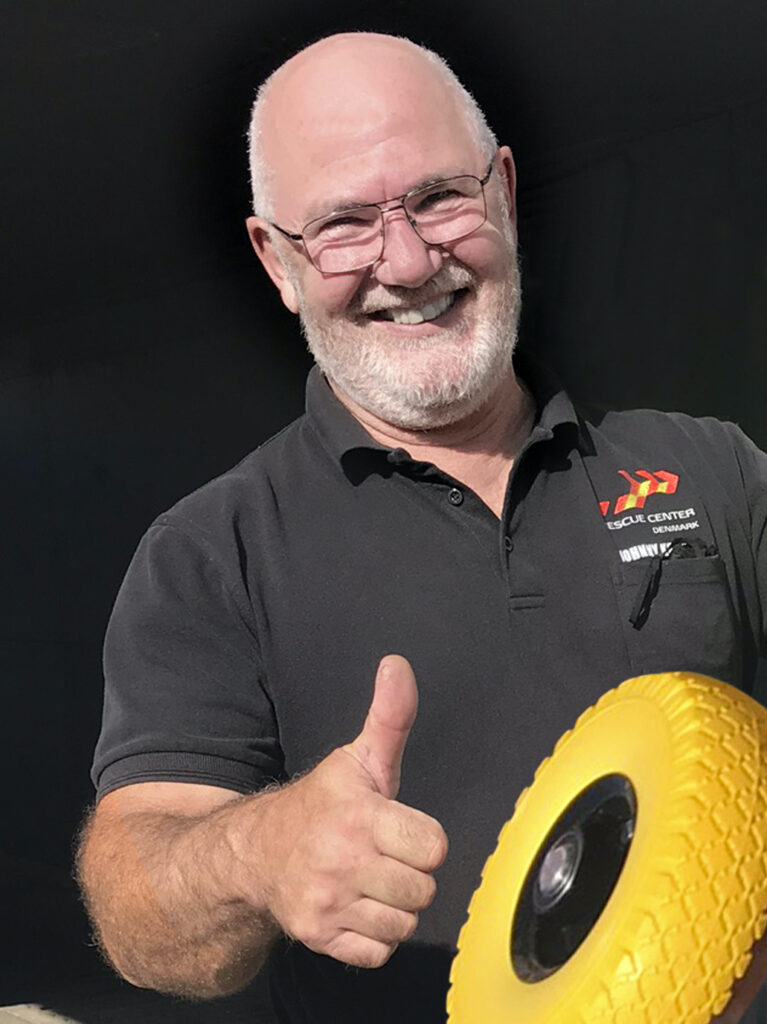
How the basket stretcher impresses with its wide range of use
Experience tells us that rescue workers use the basket stretcher for a variety of purposes. This is carried, dragged or rolled across terrain, or floats in water. To cater for this variety of applications, we have designed a fully adaptable product with the Carapace basket stretcher, which can be fitted with carry handles, runners, wheels, a guide wheel or a floatation device. Basket stretchers are not just reliable support for rescuing people on land, as the Carapace basket stretcher has also become indispensable for water rescue.
In this article, you can find out more about how the Carapace can be adapted, and about the tough conditions on land and water.
Water rescue in wind and rain
In order to understand better the demanding requirements of rescuing people from water, we sought an interview with expert Johnny Krupa. He has 20 years of experience in the rescue and medical services field and is rescue instructor at the Rescue Center Denmark in Esbjerg. There, Johnny Krupa trains both wind energy workers in how to rescue people from height, and coastal rescue workers in water rescue. Johnny Krupa feels equally at home working at height as he does on water, even though conditions when rescuing people on water are usually very tough:
“Water rescue poses far greater challenges because the weather is often very poor when you attend rescue operations on water.”
All kinds of rescue missions, whether in floods, near the coast or on the open sea, fall within the scope of coastal rescue. All the more important, then, to have the right equipment which can withstand conditions on the water and ensure the best possible support for the emergency services.
An all-rounder, whether on water or on land
The Carapace basket stretcher is already renowned for its resilience in fire or rescue operations, whether rescuing people or transporting equipment. In order to cover great distance with ease, the basket stretcher can be fitted with a chassis frame and puncture-proof wheels. These are easy to attach at the scene, quickly and easily, as required. Being able to fit wheels onto the basket stretcher quickly is of paramount importance to our expert, Krupa:

“Be able to attach wheels quickly and easily when you land back on terra firma is a major point of difference from conventional rescue equipment, and makes transfer to the waiting ambulance much easier.”
But water rescue also relies on the Carapace: thanks to the collapsible and thus space-saving Carabouy floatation device, the basket stretcher is perfectly suited for use on water. The emergency services are not hampered by any rigid, bulky flotation devices. Depending on the conditions where it is needed, the inflatable flotation device can be attached to the basket stretcher using Velcro fasteners. This means anyone being rescued by the emergency services does not have to keep being transferred from one piece of equipment to another. They can be rescued from the water, taken back by boat and handed over to the emergency services on land. It means the patient can be transported using the same stretcher throughout the entire rescue process, as unnecessary movement often poses a great risk for the patient.

So SmartEm provides a clever, combined solution meaning rescue workers are prepared for all eventualities at the scene, and always have the right equipment with them. In just a few easy steps, the Carapace becomes a rescue device appropriate for any particular situation.
Water rescue
The video which follows shows the basket stretcher with flotation device in action. A considerable part of the stretcher stays below the surface of the water – which might seem strange at first, but is essential for rescuing people.
With hypothermia, less blood flows to the fingers and toes, which is why sudden movement should be avoided. Water in and around the stretcher allows it to glide, and provides the necessary buoyancy – for everyone involved. The person being rescued is held motionless in the stretcher by the resistance of the water, and the rescue workers can keep the stretcher steady. Ultimately, this makes transport by water safer and easier:
“Rescuing people from water, but also transporting casualties – this is where SmartEm makes the life of the emergency services easier.”
As shown in the video, the Spineboard can also be of assistance in getting the person being rescued onto the basket stretcher even faster. “However, remember to remove the mat before using it in the water, otherwise it might float off out to sea,” adds Johnny Krupa with a laugh.
Rescue from height
It is not uncommon for search and rescue to use helicopters for missing people. They mean stretches of water can be covered more quickly or lifeboats can be guided towards the missing person. Scenes of rescue can be up to 15 kilometres from the coast.
The ferry disaster off Finland in 1994 involving the Estonia, where many victims did not survive being rescued from the water, showed the factors which have to be taken into account when rescuing people from the water by helicopter. Since that incident, it has been accepted practice that victims should be rescued lying horizontally. When suffering from severe hypothermia, the body concentrates its energy on the vital organs, which is why less blood flows to the fingers and toes. Suddenly taking someone out of the water also takes away the resistance of the water, which leads to a dangerous drop in blood pressure. The victims also get too relaxed, knowing they have now been rescued.
Water rescue then and now
It’s not just the equipment which makes water rescue easier today than it used to be. While, in the past, local fishermen often played an important role in rescuing people, today it is highly qualified specialists who can give comprehensive first aid and medication directly at the scene. Even in the heat of summer, casualties can develop hypothermia quite quickly, further increasing the need for the right treatment.
Conclusion
At the Rescue Center Denmark, the Carapace basket stretcher has proved its worth in water with honours. To ensure a long service life, we recommend rinsing it down with clean water after use, to remove any salt water.
Whether out at sea, on inland water or in floods – if you should ever need to demonstrate your skills in rescuing people, SmartEm can offer you full training and advice on site to check what equipment you might need. Please get in touch with Jens Hartmann regarding this.


Comments
0 comments so far